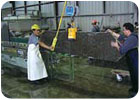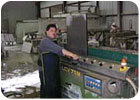
Last year's expansion has allowed Designer Stone Center of Houston, TX, to process 36 kitchens per week in a single eight-hour shift.
By investing in new equipment and facilities, Designer Stone Center
of Houston, TX, was able to remove its second shift while maintaining
the same production level - with room for expansion
In 2004, Designer Stone Center of Houston, TX, saw annual business grow from $3 million to $6 million, and to accommodate the increased business, the company was running two 10-hour shifts to manufacture some 36 kitchens a week. To offset this crunch over the long haul, Owner/President Jorge Lefevbre decided to move to larger facilities and update its equipment. The move has proven as success for Designer Stone Center, as the company was able to maintain production with only one shift, and it still has reserve capacity for future growth.
The move, which took place early last year, saw the company go from a crowded 1,200-square-foot building to a new 37,000-square-foot facility for warehousing, showroom and manufacturing operations. Lefevbre took all the company's equipment, added a second bridge saw, and is now producing the same number of kitchens in one eight-hour shift.
The additional bridge saw was a critical investment because it allowed for two complete production lines. “In the past, we were constrained by the space,†Lefevbre said. “We were producing the same number of kitchens back then, but with two long shifts. We could only use one bridge saw, because another one wouldn't fit in the space that we had. So now we have only one shift, but with two lines of production. In this new building, we could easily triple the number of kitchens we do.â€
In all, Designer Stone Center has a general manager, 17 employees on its manufacturing line, plus eight installers.

After the 2-cm stone is laminated, the workpiece is then run through a LCV 711 flat edge polishing machine from Marmo Machinery USA to grind and flatten the entire edge.
Speeding Throughput
As with his other machinery, Lefevbre chose his new bridge saw from Marmo Machinery USA. It is a twin to the saw that he moved from the old building - the Marmo Machinery USA HTO-1B - with a 16-inch diamond blade that has a production capability of 120 lineal feet of 3-cm material per hour. Because Houston is a 2-cm (3â„4-inch) market, throughput potential is even faster, although Lefevbre said he is more concerned with kitchens per shift than the theoretical number of feet per hour. The saw moves on the rails of a double beam bridge, and an oil bath reduces wear of the rollers and bearings running in the harsh environment of Lefevbre's shop.Each of the HTO-1B bridge saws has a cutting area of 140 x 140 inches, and the 7-foot bridge height allows an operator access without having to bend over to walk beneath the grid. The HTO-1B also uses a hydraulic tilt table that allows material to be loaded from a slab lifter or forklift. Each of these two saws is built to cut 12 to 15 slabs of granite, marble, porcelain or engineered stone per eight-hour shift.
“Having two of the same machine also helps me out by reducing spare parts inventory,†Lefevbre said. “I don't have to double the spare parts that I need to keep on hand for routine maintenance. If I need to replace a couple of hoses or something else, the same parts fit either machine, even though they were built in different years.â€
In addition to the two saws, Designer Stone Center also has a LCV 711 flat edge polishing machine and two LCT 522 vertical polishing machines for edging operations, all Marmo Machinery USA machines.
Processing the Workpiece
During the fabrication process, a slab is loaded onto a bridge saw, cut to required dimensions, and brought into the next step, which is the lamination process. During this stage, a strip of granite is glued to the 2-cm edge to give it a 1 1â„2-inch thickness. The workpiece is then run through the LCV 711 flat edge polishing machine to grind and flatten the entire edge. From there it goes to one of the LCT 522 vertical polishing machines.The LCT 522 is designed to handle seven or eight bullnose profiles. They can polish squared off and inclined edges on granite slabs as well as torodial edges and other convex shapes. At Designer Stone Center, however, the two machines are each dedicated to just one profile. “I don't go crazy offering 20,000 different edges to people,†Lefevbre said. “We keep our products simple. Once we adjust a machine, we leave it that way. This reduces tool change and set-up time. On one machine we run waterfalls, and on the other one, we run bullnoses.â€
Designer Stone Center does approximately 70% granite and 30% marble, with occasional projects in limestone and travertine. The company does not manufacture from engineered stone, but its installation crews measure templates and provide installation for other companies that work with these materials. Designer Stone Center's business is 100% residential.
Turnaround time is usually 10 calendar days from the time a builder places an order until the finished countertop is installed on the jobsite. When Designer Stone Center gets a dealer's order, the shop manager assigns it a job number and puts in a requisition for materials. The materials are then brought into a staging area and assigned to a production line.
While sink cutouts and similar operations are performed with hand tools, Lefevbre said that he will be adding a CNC machine from Marmo Machinery USA in the near future. In addition to sinks, it will also automate the production of islands.
Designer Stone Center
Houston, TX
Type of work: Residential countertops
Machinery: Two Marmo Machinery USA HTO-1B bridge saws; one Marmo Machinery USA LCV 711 flat edge polishing machine; two Marmo Machinery USA LCT 522 vertical polishing machines for edging operations
Production rate: 36 kitchens per week
Countertop sales: $6 million per year